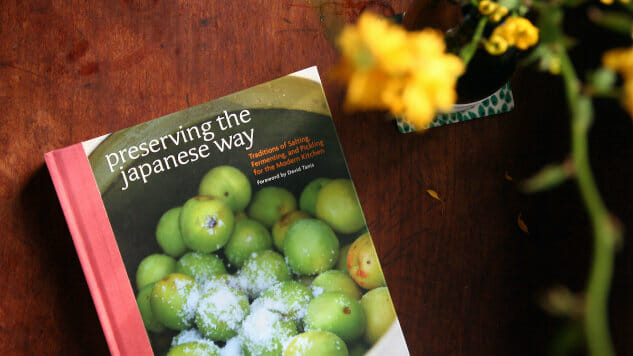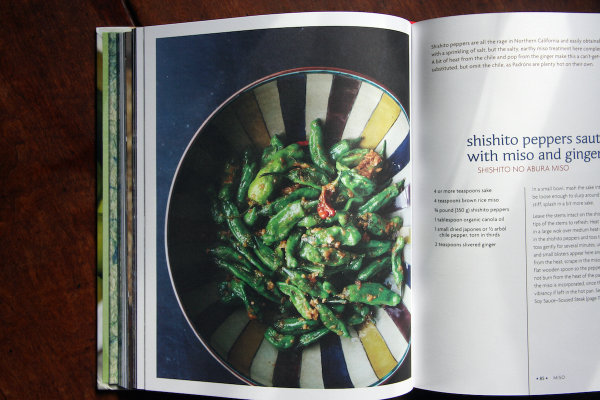Wild Culture: Learning About Japanese Fermentation with “Preserving the Japanese Way”
Photos by Anna Brones Food Features
Earlier this spring I was invited to the house of a Japanese friend, for the celebration of Hinamatsuri, a day to celebrate female children and to bring them health and happiness. In honor of the celebration, she prepared a full spread of Japanese food, even incorporating more local ingredients – like a swiss chard roll with sesame seed sauce – to connect an exotic meal to the place where we were eating it. The meal was simple and complex all at the same time, an array of flavors that fit perfectly together. I felt like I could eat like this every day, and it left me craving more.
Having never traveled to Japan, my knowledge of Japanese food culture has always been limited to what I found outside of Japan, first sushi and then the small plates offered at izakayas. But then I received a copy of Nancy Singleton Hachisu’s book “Preserving the Japanese Way.” At first I was tempted simply because the book focused on the topic of fermentation, but as I read through it I became more and more intrigued by the complexities of Japanese cuisine, and the time and dedication that Japanese food artisans put into their craft. Because while “Preserving the Japanese Way” is a book about fermentation, it is also a book documenting the heritage of a country’s food culture, and in that way, “preserving” takes on a double meaning.
Traditional Japanese cuisine is considered one of the healthiest in the world, in which fermentation certainly has an influence. From sake to soy sauce, fermentation plays an integral role in Japanese food culture. Hachisu covers many of these Japanese basics, but even if you were to never try them at home (which would be a shame), her writing will help you to have a much better understanding of the work and time that goes into Japanese food.

Like with all fermentation, what’s exciting about Japanese fermented foods is how much they are representative of place. In wine, we often talk about terroir, but fermentation comes with its own terroir, flavors influenced by where we are in the world.
Hachisu writes about miso, something that she recommends everyone to try their hand at. “Each miso is different because each person is different and each locale has its airborne spores that affect the miso (for the better),” writes Hachisu. This reminds me of sourdough starters and sourdough bread; the fact that wherever you are in the world, your sourdough starter will be different, and in turn, the resulting loaf of bread, because of the wild yeasts on hand.
While the book is focused on Japanese foods, Hachisu’s advice could go for any fermentation project, whether it’s one of her more complex, long-term Japanese projects — like fish sauce, which can take anywhere from one and a half to three years — to shorter projects that take only a few days. “Learn from your mistakes. Fix them. Each year you will get better. And realize that the window to perform many of these projects is short. Try approaching them without ego. Rather than deciding when ‘you’ want to do it, determine the best timing for your area and climate and give in to that,” writes Hachisu.

The recipes that got me the most excited were the seasonal ones, the ones that I could test out right now, like Salted Cherry Blossoms (my cherry blossoms layered with salt are currently sitting in a dark cupboard doing their thing). As Singleton Hachisu writes, “salt is ground zero for preserving,” and many of the recipes in the book are as simple as massaging salt into a fresh ingredient, like shisho buds or mizuna.
But what makes Hachisu’s book distinct besides her mastery of traditional recipes are her profiles of artisans and traditional food methods, and the resulting takeaways for us the readers. Just like in the United States, the younger Japanese generation has grown up with the easy accessibility of staples like soy sauce, industrialization making it easy to produce foods on a mass scale.
Yet this has all come at a cost, both social and environmental. “The cheapest soy sauces are made by mixing hydrolyzed vegetable protein with caramel color, corn syrup, and salt; but all breed or so-called natural soy sauce contains salt, water and koji, a culture used to make soy sauce. No mistake there. However, large companies use a base of processed defatted soybeans instead of whole soybeans and sometimes wheat bran instead of whole wheat berries to create their soy sauce,” writes Hachisu. She continues, “Yes, the soy sauce is made with a soybean product and wheat product, but most of the companies’ soy sauces are no longer made in the traditional method… The shape-shifting bothers me in this world, where we need to trust our food producers.” What I appreciate about her book is that Hachisu not only recommends which products we should choose, but she also explains the why.

I have picked this book up to read many times, less as a cookbook and more as an encyclopedia, a look into a food culture that intrigues and excites me. Hachisu weaves together an exotic world of sour plums, sake, salted fish and rice bran pickles, but while many of the recipes are foreign to me, and a challenge to break out of my usual culinary box, the lessons are universal.
Fermentation requires time and patience, but the payoff is huge, both in terms of physical and emotional health. When we ferment, we take part in a living system of wild yeast and preservation, one that has guided our food system since the early days. Ultimately, Hachisu’s book is a reminder that good food takes good time, that cutting corners may lower the price tag, but still comes at a high overall cost, and that if we better understand our food, and the people who produced it, we will take greater pleasure from it.
Anna Brones is the author of The Culinary Cyclist and Fika: The Art of the Swedish Coffee Break and runs Foodie Underground, a site about real food for real people. Wherever she is in the world, she can often be found riding a bicycle in search of excellent coffee.